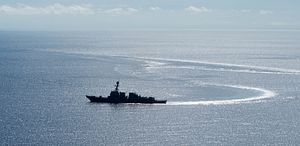The United States Navy reportedly tested an advanced long-range artillery round from a destroyer at last summer’s Rim of the Pacific exercise. Defense officials told USNI News that the USS Dewey fired 20 High Velocity Projectiles (HVP) last summer as part of a study on the feasibility of using the rounds against air threats like anti-ship cruise missiles and Unmanned Aerial Vehicles (UAVs).
Originally designed for a shore bombardment or anti-ship roles, the U.S. Navy soon realized the HVP’s air-defense potential and it was reported in 2016 that the Pentagon wanted to conduct a demonstration of that role by 2018.
The HVP was designed in concert with the U.S. Navy’s electromagnetic railgun (EMRG) project. The EMRG was envisioned to propel the HVP to speeds exceeding Mach 6 to a range of 100 nautical miles. Hypersonic speeds are considered anything above Mach 5.
Fired out of a conventional 5-inch gun using chemical propellants instead of electromagnetic energy, the U.S. Navy believed HVP could achieve speeds of roughly Mach 3, about twice the speed of conventional ammunition, and a range of 40 nautical miles, substantially greater than the 5-inch gun’s current 13 nautical mile range. Since hypersonic speeds are not achieved when fired out of a conventional 5-inch gun the version of the HVP round that will be used in that role is called Gun-Launched Guided Projectile (GLGP).
The U.S. Navy tested an earlier long-range precision round intended for its conventional 5-inch guns in the early 2000s called the Extended Range Guided Munition (ERGM). The ERGM used a much different design than the HVP or GLGP. It achieved its design 60 nautical mile range using a rocket motor that ignited after being fired out of the gun barrel. Individual ERGM rounds cost nearly $200,000 each and the U.S. Navy cancelled the program in 2008.
The HVP/GLGP does not rely on a rocket assist and uses only the ballistic energy transferred by being fired out of a gun barrel. The HVP/GLGP’s estimated cost is about $85,000 per round. By contrast, the Evolved Sea Sparrow missile that the GLGP may one day replace for some air defense applications cost nearly $1 million each.
In addition to this cost advantage, a Congressional Research Service report explains that GLGPs fired from conventional 5-inch guns could also significantly expand U.S. cruisers’ and destroyers’ capacity to both defend themselves and conduct other missions. This is because ships can carry hundreds of artillery rounds but many fewer missiles. U.S. Navy destroyers have about 90 launch cells to carry a variety of missiles, and cruisers have 122.
Each launch cell that must be dedicated to anti-air missiles to defend the ship against high-speed anti-ship cruise missiles takes capacity from those ship’s other critical missions. By reducing the self-defense burden that is currently carried by anti-air missiles, ships can carry more Tomahawk cruise missiles for striking land targets, rocket-launched torpedoes for use against submarines, and future anti-ship missiles to use against adversary fleets.

































